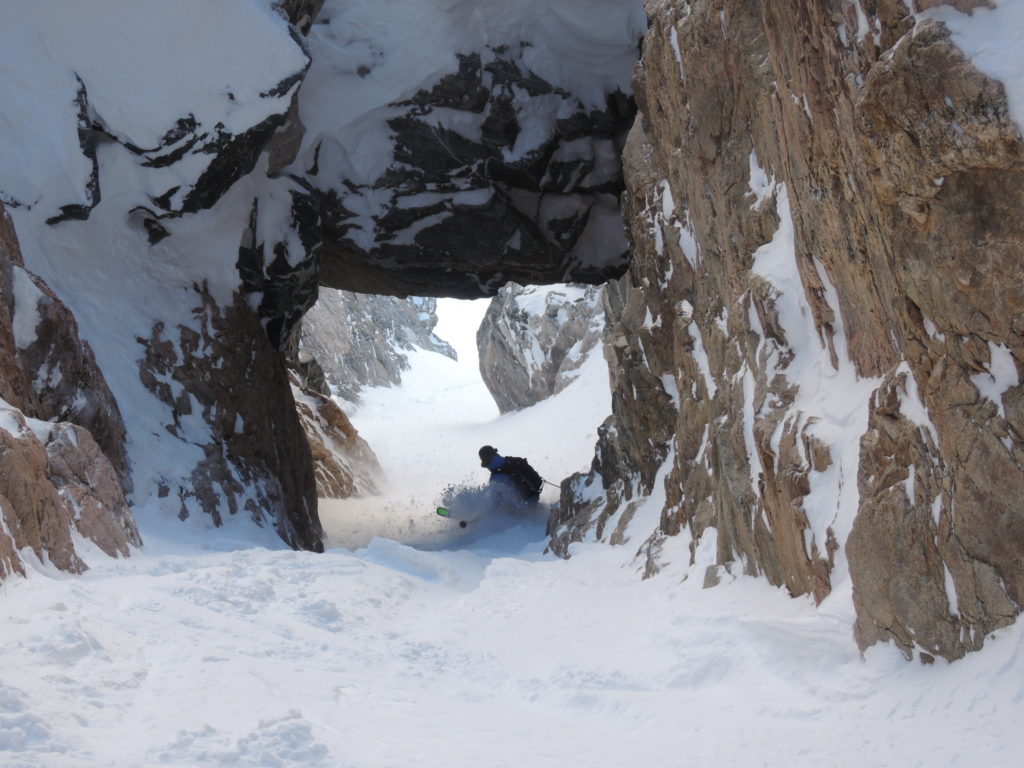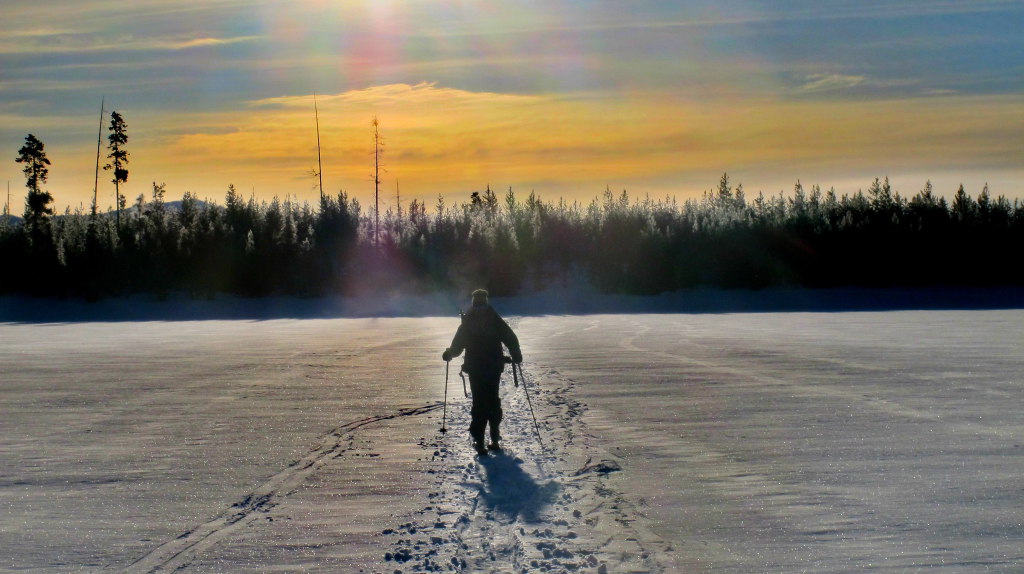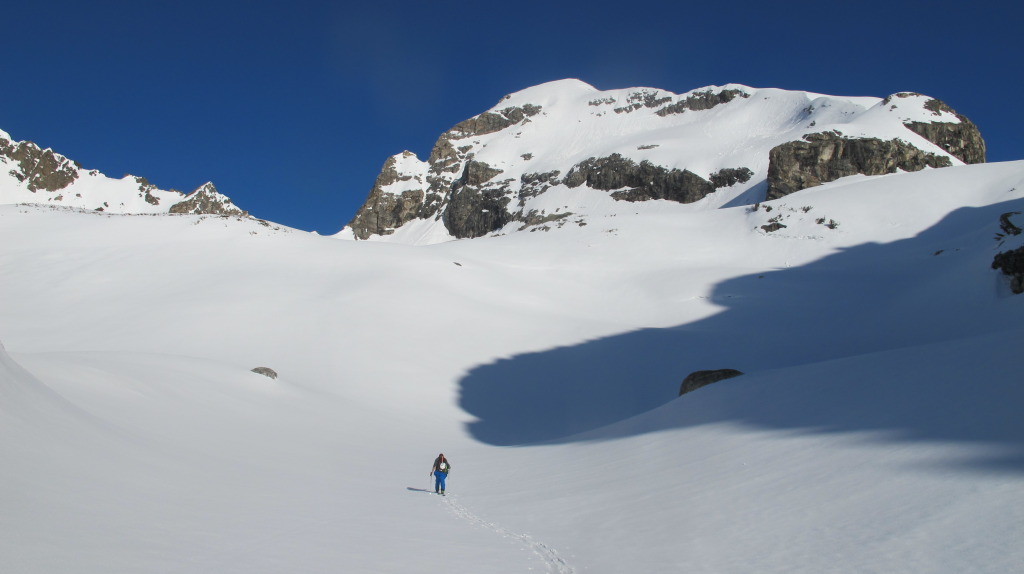The Apocalypse Couloir
Date: February 11, 2013
Temperature: -18F
Time: 6:00AM
It’s cold. Really cold. The type of cold that I don’t just feel, but I can hear. The high-pitched squeak of every step is like a scream coming from the snow, letting me know that I’m not alone in my discomfort. It didn’t help that the heater in my truck was broken, making the 45-minute drive to the Death Canyon Trailhead in the dark that much more painful. Sorting out gear in the parking lot, freshly formed crystals of surface hoar glistening in our headlamp’s beams, I can’t help but be concerned that, despite wearing every layer I brought, I’m freezing.
It’s beautiful though, too. Silent. Clear. Still. It’s the type of morning that’s been a precursor to more great days than I can remember. We tour out of the parking lot and gain some elevation to a ridgeline before dropping onto Phelps Lake. The cold is a good motivator, unsung encouragement as we head south toward Prospectors Mountain and the start of the Apocalypse Couloir. The line is a classic, several rappels provide access to a 2000’ couloir that doglegs right before being pinched by two ice flows in a section so narrow and icy it sometimes requires another rappel.
We get glimpses of the exit of the line as we cross the lake, but the couloir wont be in full view until we’re getting ready to make our first turns. It’s a solid two hours before my internal temperature, aided by movement and the slow-to-rise sun, warms enough for me to shed a layer. By that time, however, the cold has been pushed to the recesses of my mind, with the task at hand taking precedent.
We reach the entrance of the couloir, an unremarkable indent in the ridge amongst a small group of trees, with little fanfare. After a quick snack, we gear up for the several raps into a line that we still haven’t properly seen yet. Zahan, Exum guide and all-around mountain man, handles the ropes and, before long, we’re into the protection of a cave that sits at the top of the line. While a cave is an odd place to build anticipation for a line, it’s eerie calm seems fitting for the day and its protection offers a welcome respite from the sluff pouring down the couloir, initiated by the rest of the crew as they make their way down.
There may be no sweeter powder turns than those built up by hours of anticipation and shrouded in the uncertainty of a line that one can’t fully see. While I’d imagined and hoped that the north facing, protected couloir would be holding some of the best snow in the Tetons, the confirmation of that wish is nothing short of magical. Making sweeping turns from wall to wall in perfect, boot-top pow, our crew carefully dissects the upper portions of the Apocalypse. Each turn is filled with the combination of stoke and awe from a place that is so beautiful, under conditions that are so ideal. As we approach the crux of the ice flow, it’s difficult not to just stand in wonderment, the moment of anticipation as poignant as the skiing itself.
Beyond being nearly jammed, tip-to-tail, between two ice-flows, the crux isn’t as puckering as it could be under the wrong conditions. A solid blanket of snow provides enough purchase on the ice and, harnessing our inner Scot Schmidt, we make tight jump turns for several hundred feet, our tips and tails occasionally deflecting off the walls of blue ice. Beyond the icy choke, the couloir gives way to a massive apron and before long we are back in the valley, accompanied by a familiar chill that is setting back in for the evening.
The Chockstone Couloir
Date: January 6, 2014
Temperature: -10F
Time: 7:00AM
The sky is exploding. Figuratively speaking, of course. The day’s first rays of light are striking the spindrift blowing off the ridges of Mount Wister and the South Teton in such a way that the entire valley is glowing red. As we make our way across Taggart Lake and toward Avalanche Canyon, the valley’s ambient red glow matches the tone of the day: mellow. We’re out for a walk, perhaps a short line, but more of a mellow cruise, away from the crowds of the resort, than anything else.
Our jaunt will take us up the drainage that separates the South Teton from Wister and Buck, and provide a boots on the ground view of how some of the bigger lines in the park—the Newc, Amora Vida, and South East Couloir on the South Teton—are filling in. It’s a recon mission, but a beautiful one at that.
The walk up Avalanche canyon is a slow one. Not because of snow or weather, but simply because the scenery in the soft January light is so beautiful. It’s difficult not to stop every few paces just to examine the intricacies of the mountains. Left step, right step, stop, look around. The process repeats itself over a couple hours as we slowly gain the headwall to Lake Taminah, which serves as the terminus of lines off the South Face of the South Teton and the north side of Wister.
At the lake, a sharp west wind blowing down-canyon provides a greater sense of urgency. The wind is blowing so hard the lake has been nearly stripped clean of snow, leaving a polished sheet of blue ice behind. After a hurried lunch crouched behind a semi-protected boulder, we head further up the canyon to gain beta on various lines in the area, all the while looking for a consolation prize for the day.
It doesn’t take long to find just what we’re looking for. Off the north face of Mt. Wister, a short couloir that tunnels under a massive chockstone seems like a perfect objective. On most days, this would be an add-on to one of the bigger lines in the area, but today it seems like an acceptable goal in itself. Not to mention, as the winter rolls on, the line will undoubtedly disappear, buried in snow.
After a satisfying look at the Amora Vida, one of the more prized lines in the park that doesn’t quite look to be filled in yet, we turn back toward the chockstone. The light snow in the narrow couloir makes for difficult hiking, but we’re reassured by the quality and stability of the snow. By the time we work our way underneath the chockstone and to the end of the couloir, the slope has gotten so steep it’s difficult to put our skis on. Battling regular deposits of sluff coming off the north face of Wister, we finally manage to transition and drop into our short, yet unique line.
The first part of the line is so steep that we can’t help but leap down several feet between each turn. It almost feels as though if we had enough spring in our turns, we could knock our heads on the chockstone as we pass beneath the massive boulder. Tunneling back underneath the stone and through the rest of the couloir, the snow is perfect, with enough forgiveness to slow us down yet enough pop to make it exciting. Opening up our turns through the fields of glory at the bottom of the line and onto the wind-swept ice of Lake Taminah, we’re as satisfied as if we had bagged one of the larger lines in the area. The line, the snow and the general tempo of the day were nothing short of perfection. I suppose some days, all one needs is a long walk and an add-on.
The South East Face of the South Teton.
Date: March 13, 2014
Temperature: 7F
Time: 4:30AM
I’m scared. Perhaps as scared as I’ve ever been skiing a line. Cautiously yet quickly trying to make my way down a couple thousand feet of a hanging snowfield, above another thousand feet of exposure, I’m doing all I can do not to crash. I thought, with close to three decades of skiing under my belt, I’d seen every type of snow there was, but this is something new. There’s a two-inch thick, unsupportable solar crust covering about 18-inches of some of the lightest snow I’ve ever seen in the Tetons. The combination is terrifying. The crust is so thick and uniform that at times it breaks off in plates the size of turkey platters. My tips dive and my skis accelerate in the light snow, yet my legs get caught in the thick crust. It’s like the snow is constantly trying to throw me over the bars and down the slope. All I can think of is getting off of this mountain.
The day started innocently enough. Our pre-dawn departure from Taggart Lake Trailhead was under clear and calm skies, building anticipation for a seemingly perfect day to come. Working our way up Garnet Canyon and toward the col between the South and Middle Teton, everything seemed to be going as planned. Our timing was good, the weather was holding and the snow seemed to be as light as the day before, despite the prior day’s warmth.
And then the wind started blowing.

The South Teton. The line descends the large hanging snowfield skiers right of the picturesque couloir.
While it’s more common than not to have west winds ripping through the col between the South and Middle Teton, the day’s wind seemed particularly brutal. With the stronger gusts powerful enough to shake one’s balance when facing broadside to the west, the wind was powerful enough that hearing each other even became an issue. Not to mention the biggest concern of snow transport on the alpine face we were headed toward.
By the time we reached the summit of the South Teton, the wind was ripping entire sheets of snow from the ridges and carrying them to the plains of Wyoming to the east. Several hundred feet lower across the upper scree fields it was a different story, however. The winds had abated and it seemed that only the highest elevations were taking the brunt of the wind. Cautiously optimistic and after extensive slope assessment and ski cuts, we got prepared for what seemed to be a day salvaged.
Now, part way down the slope, realizing the full gravity of my predicament, all I can focus on is getting to the safe zone to the skiers left of the face, on a saddle between the main slope and an arête. The run seems to be lasting forever–a circumstance I’d usually enjoy–if it weren’t for the feeling of being in a constant state of recovery. Left turn, almost crash, collect myself, right turn, almost crash, collect myself. There’s nothing fun about it, and the worst part is that the run is long enough for me to fully realize how gripped I am. There’s just too much time to think.
By the time that I make it to the safe zone I have just enough breath to take a sigh of relief. Looking back up at our tracks, the snow looks pretty good–evenly spaced, deep tracks tell a completely different story than what actually happened. If I didn’t know any better, I’d guess that it was an all time run, not a line that was as puckering as they come.
Buck Mountain
Date: May 21, 2014
Temperature: 28F
Time: 6:00AM
We’re a full on junk show. The car’s overheating, the Moose-Wilson road, which connects Teton Village to Grand Teton National Park, is closed, and we’ve spent nearly as much time on the approach to the trailhead, as we’re going to spend climbing 11,939’ Buck Mountain. It’s not even five in the morning and we already have a days worth of stories to file under misadventure. But it’s okay. It’s the middle of May and, while skiing still weighs heavily on our minds, if we have to turn around because of the days heat it wont be the end of the world.
That said, however, we’re trucking through the dirt and mud, headed toward Stewart’s Draw, trying to make up time. The bushes are thick, made more complicated by the downed timber, and we can’t help but joke that if we were bears, we’d definitely be hanging out in this area.
The eastern sky is turning from pink to dusty blue by the time we reach the snow line and the firm, refrozen snow is a welcome change from the undergrowth. Plus, we reason, we’ll be able to spot the bear before it eats us on these open slopes.
The approach to Buck is a cruiser. A couple of headwalls eventually give way to the alpine, providing a great view of the couple thousand foot east face. The inch of snow that fell the previous evening in the mountains contrasts spectacularly with the valley below, which has fully embraced spring, with bright green fields stretching out as far as we can see.
As tempting as it is to indulge in the views, our early morning shenanigans have left us well behind schedule. Switching over to crampons, we begin to climb as if the bear has finally tracked us down. The route takes us cross fall line, between two large cliffs, before heading straight up toward the summit. The climbing is beautiful, albeit a bit soft. By the time we reach the final pitch, the day’s heat is beginning to take effect on the snow, even though it’s not even nine o’clock. After a brief discussion, we decide that we have ample time to make it to the top before the any danger really sets in.
Buck has a picturesque, pyramid-shaped summit from which one can easily become lost in the view, daydreaming about different lines in the park. From where we sit, we can see the top of the Apocalypse, most of the South East Face of the South Teton and the south side of Mt Wister. The memories of all the different lines come flooding back, followed by visions of more lines in seasons to come. As tempting as it is to talk and scheme about future plans, the sun is heating the face rapidly and it’s time to get down to business.
Despite all the mishaps in the pre-dawn hours, our timing is perfect. The snow is in mid metamorphosis, between ice and slush, and we’re treated to perfect corn all the way down the face. The steep section toward the summit provides enough pitch for a quick thrill, while the mellower side hill across the face allows us to make large, sweeping turns down to the benches below. By the time we stop at the bottom of the face, we’re on the verge of laughing aloud. Did the day go as planned? Not even close. But, misadventures are an undeniable part of the process. Without them, the day—and in this case the skiing—wouldn’t have been nearly as fun.
Griffin lives in Jackson, WY, where he refuses to use a boot with a walk mode. If you see him in the Park, be polite as you pass him on the skin track.

















